|
 |
|
|
|
|
|
|
|
|
|
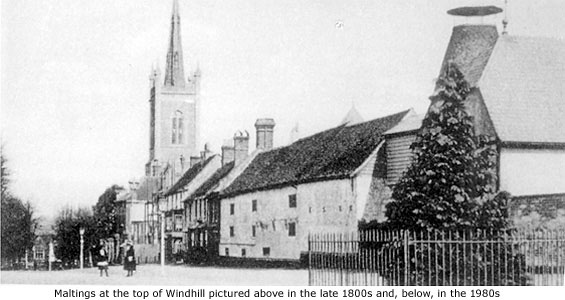 |
|
Two private houses at the top of Windhill once formed a small 17th century malting that remained in use until about 1906. Still intact is the large conical kiln chimney and the small link bridge between the two buildings from which barley grain was hauled up from carts below.
In 1897 celebrations were held throughout the town to mark Queen Victoria’s Diamond Jubilee. To commemorate the occasion, and for others to remember the event in future years, Mrs Marshall-Taylor, wife of the Chairman of the Urban District Council, planted a Cedrus Atlantica tree at the top of Windhill – approximately where the small roundabout is sited today. Enclosed within iron railings it was a prominent feature for many years, but it seems nobody realised at the time just how big the tree would grow and it was later removed for becoming a traffic hazard. The 'young' tree can be seen on the right of the picture above.
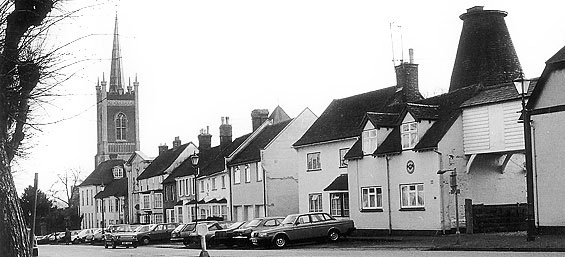
|
|
|
|
St Mary's School
|
|
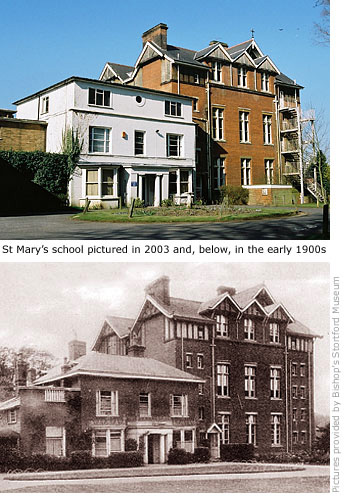 When the Sisters of St Mary of Namur arrived here from Belgium in 1896, their intention was to start a school for Bishop's Stortford's Catholic community (See St Joseph's Church). That same year they acquired Windhill Lodge at the top of Windhill, renamed it St Mary's Convent and opened their school in the same building. There were just nine pupils at the start. The original building still stands but has since undergone a great deal of alteration and is now used only for administration purposes (see photograph, left). Helped by funding from the Catholic Church, the much larger school house that stands alongside the old convent was built in the early 1900s. This opened as a fee-paying school. When the Sisters of St Mary of Namur arrived here from Belgium in 1896, their intention was to start a school for Bishop's Stortford's Catholic community (See St Joseph's Church). That same year they acquired Windhill Lodge at the top of Windhill, renamed it St Mary's Convent and opened their school in the same building. There were just nine pupils at the start. The original building still stands but has since undergone a great deal of alteration and is now used only for administration purposes (see photograph, left). Helped by funding from the Catholic Church, the much larger school house that stands alongside the old convent was built in the early 1900s. This opened as a fee-paying school.
But not every Catholic family in Bishop's Stortford could afford to pay for their children's education, so in 1909 a mixed school for elementary pupils began at St Mary's for the less well off. Named St Joseph’s, it first accommodated pupils in two classrooms in what is now the music block, but by 1914 the school had grown so rapidly that a staff of three were teaching 57 children.
During the First World War, soldiers were billeted in St Mary’s at night and many child evacuees from London were taught here during World War II.
As Stortford's Catholic community grew, space was at a premium and for a brief spell some children were taught at St Joseph’s Church Hall in Apton Road. After World War II additional classrooms were used at the Secondary school in the Causeway (See Guide 7), and later many more pupils were housed in the Evening Institute at Church Street. They remained there until a new St Joseph’s school was built at Great Hadham Road in 1960.
|
|
|
|
Old Windhill Road
|
|
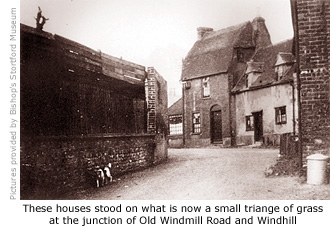 This narrow lane that runs along the south side of St Mary’s school was the original route from Bishop’s Stortford to Great Hadham (now Much Hadham). The present route (via Windhill) was constructed in the early 19th century to bypass it. The small triangle of grass at the start of Old Windhill Road once supported two small houses, used during World War II as a lookout point by local Fire wardens. This narrow lane that runs along the south side of St Mary’s school was the original route from Bishop’s Stortford to Great Hadham (now Much Hadham). The present route (via Windhill) was constructed in the early 19th century to bypass it. The small triangle of grass at the start of Old Windhill Road once supported two small houses, used during World War II as a lookout point by local Fire wardens.
There is every indication that between 1676 and 1765 a windmill once stood in this area (although its exact location isn’t known), records showing that two cottages were sold in Apton Field on land where a windmill had once stood. Apton Field is associated with Apton Road of today, Apton being a shortened version of Appleton and Apton Field being formerly Appleton Field. Early maps show two small fields between Old Windhill Road and Apton Road; one named Windmill Pasture, the other Windmill Mead. Windmill pasture was the area of land that is now bounded by Old Windhill Road and Windhill.
|
|
|
|
Windhill (St Catherine's School)
|
|
Alongside No 21 Windhill stands a residential development named St Catherine’s Court, built on the former site of the 19th century St Catherine’s School that later became Waterside School. That school was founded in 1921 but before moving to here had previously been located at three other sites in the town: Water Lane (See Guide 6), Church Street (See Guide 15) and Causeway (See Guide 8), the last of which they were forced to move from in 1964.
The former buildings of St Catherine’s School that stood here were ideal for Waterside School to take over, and after some renovation work opened on the 9th October 1965. The school proved extremely popular and was enlarged in 1969 to cater for additional pupils. But by the early eighties, land in and around the town was being sought by property developers and the school’s prime position made it an obvious target. After 22 years on this site it relocated for the last time in 1987 to the Hassobury estate at Hazel End where it occupied a 19th century gothic mansion.
Since its beginnings in 1921, Waterside School had always been a ‘mixed’ school but in 1988 changed to single sex, girls only. Unfortunately, being a private school, it was not immune to financial problems and finally closed for good in the early 1990s.
|
|
|
|
Elmhurst (Hurst Close)
|
|
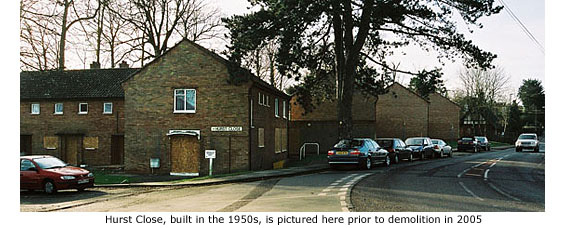
The summer of 2005 saw the demolition of Hurst Close in Windhill – a small development of 1950s council-built accommodation for the elderly, cleared to make way for a more modern housing association development. Also demolished was a small lodge house in Windhill that stood at the entrance drive to Elmhurst. Work on the new development was completed at the end of 2006.
The former Hurst Close had been constructed on part of the 8 acres of land that once formed the grounds of Elmhurst – a large family house built by brothers William and Hubert Gee in the mid 1800s (See this Guide – High Street).
Elmhurst came up for sale after the Second World War, and Herts County Council acquired the site. Their intention was to turn the house into a residential nursery and use part of the grounds, adjoining Apton Road, for a new primary school. This was to replace the 19th century built St Michael's school already in Apton Road (See Guide 14 – Apton Road). The new school was built in the 1950s but Elmhurst itself was eventually used as a hostel for the aged. This was later demolished and replaced in 1988 by the present Bishops House Day Centre, run by Hertfordshire Social Care.
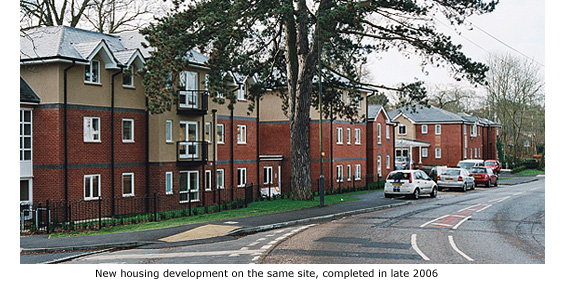
|
|
|
|
St Joseph's School
|
|
When built in 1960 this new school had just three classrooms, making it necessary for many pupils still to be taught at St Mary’s School. A further three classrooms were built in time for St Joseph’s official opening in 1966, but even they proved insufficient for Bishop’s Stortford’s rapidly growing population. With finances already stretched to the limit a fund was set up into which parents contributed at least one penny per week, eventually raising enough money to build the extra classrooms needed. Currently (2004) the school accommodates in excess of 300 pupils. MORE PICTURES
|
|
|
|
[ BACK TO TOP ] |
|
|
|
|
|
|
|
|





 When the Sisters of St Mary of Namur arrived here from Belgium in 1896, their intention was to start a school for Bishop's Stortford's Catholic community (See St Joseph's Church). That same year they acquired Windhill Lodge at the top of Windhill, renamed it St Mary's Convent and opened their school in the same building. There were just nine pupils at the start. The original building still stands but has since undergone a great deal of alteration and is now used only for administration purposes (see photograph, left). Helped by funding from the Catholic Church, the much larger school house that stands alongside the old convent was built in the early 1900s. This opened as a fee-paying school.
When the Sisters of St Mary of Namur arrived here from Belgium in 1896, their intention was to start a school for Bishop's Stortford's Catholic community (See St Joseph's Church). That same year they acquired Windhill Lodge at the top of Windhill, renamed it St Mary's Convent and opened their school in the same building. There were just nine pupils at the start. The original building still stands but has since undergone a great deal of alteration and is now used only for administration purposes (see photograph, left). Helped by funding from the Catholic Church, the much larger school house that stands alongside the old convent was built in the early 1900s. This opened as a fee-paying school. This narrow lane that runs along the south side of St Mary’s school was the original route from Bishop’s Stortford to Great Hadham (now Much Hadham). The present route (via Windhill) was constructed in the early 19th century to bypass it. The small triangle of grass at the start of Old Windhill Road once supported two small houses, used during World War II as a lookout point by local Fire wardens.
This narrow lane that runs along the south side of St Mary’s school was the original route from Bishop’s Stortford to Great Hadham (now Much Hadham). The present route (via Windhill) was constructed in the early 19th century to bypass it. The small triangle of grass at the start of Old Windhill Road once supported two small houses, used during World War II as a lookout point by local Fire wardens.
